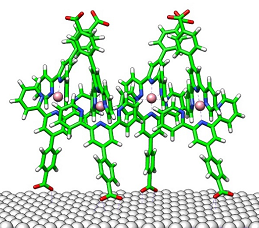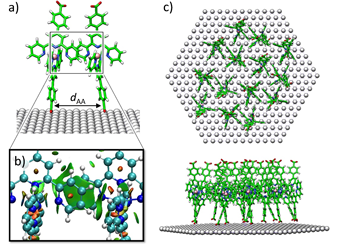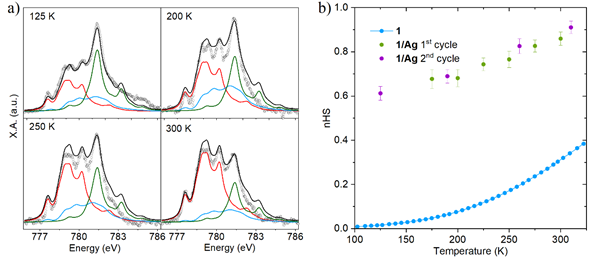Do you want to keep up to date? Subscribe to our newsletter. 1 mail every 2 months! |
 |

Spin-crossover grafted monolayer of a Cobalt (II) terpyridine derivative functionalized with carboxylic acid groups. Credit: Advanced Functional Materials.
Cerdanyola del Vallès, 8th September 2023 The integration of magnetic switchable materials in molecular electronics has recently aroused great interest. In this regard, spin-crossover (SCO) complexes represent one of the most spectacular examples of molecular bistability since both low-spin (LS) and high-spin (HS) states are reachable through external stimuli such as temperature, pressure, or light. Deposition of these complexes on solid surfaces is a mandatory step for many applications as electrical switches or mechanical actuators. Over the past ten years, the preferred method for depositing this type of systems has been sublimation in ultrahigh vacuum (UHV) of neutral complexes. However, this deposition method has restricted these studies to a few families of vacuum evaporable molecules.
Researchers led by Prof. Matteo Mannini (Department of Chemistry “Ugo Schiff” and INSTM Research Unit, University of Florence) and Dr. Miguel Clemente-León (ICMol, University of Valencia) have developed an alternative method based on the grafting of properly functionalized Cobalt (II) SCO complexes from solution. Raman spectroscopy, X-ray absorption spectroscopy – performed at BOREAS beamline of ALBA – and X-ray photoelectron spectroscopy, supported by first-principles calculations, have confirmed that the deposited molecules undergo a spin transition with temperature.
In a recent study published in Advanced Functional Materials the researchers report a general simple grafting method that only requires molecules functionalized with suitable anchoring groups able to interact with the surface. Previous attempts of the deposition of SCO complexes with this method failed because of the redox instability of the tested iron Fe(II) molecules. In contrast to this, more robust [CoII(HL)2]2+ (HL = 4´-(4-carboxyphenyl)-2,2’:6’,2’’-terpyridine) complexes could be successfully grafted on silver surfaces maintaining the SCO behavior.

Figure 1. a) Minimum-energy structure calculated for the most stable Co(II) SCO complex dimer at a fixed anchor-anchor distance (dAA) of 10.5 Å using the GFN2-xTB method. b) Inset displaying the NCI surfaces for the π– π and CH··· π interactions that stabilize the supramolecular SCO complex dimer. c) Top and side views of a schematic model of the Co(II) SCO monolayer.
The morphology, stability, and composition of the deposited monolayers were studied by atomic force microscopy, matrix assisted laser desorption ionization - time-of-flight mass spectrometry, X-ray photoelectron spectroscopy and Raman spectroscopy. SCO properties were studied by X-ray absorption spectroscopy, performed at ALBA, X-ray photoelectron spectroscopy and Raman, assisted by first-principles calculations. As mentioned, these three techniques confirm that the spin state of the Cobalt (II) complexes on top of Silver displays gradual and reversible changes with temperature. This is something unprecedented for a grafted monolayer of SCO complexes anchored on a metallic substrate from solution paving the way to the realization of SCO nanodevices through soft methodologies.

Figure 2. a) XAS Co L3-edge of the grafted monolayer (1/Ag) at each temperature (empty circles) together with HS Co(II) (red curves), LS Co(II) (blue curves) and LS Co(III) (green curve) components. Black line is the best fitting curve with the sum of the three components. b) HS Co(II) molar fraction thermal distribution obtained from standard magnetometry on a polycrystalline sample of the bulk sample (1, blue dots) and from the XAS regression of 1/Ag in the first (green dots) and second (purple dots) warming/cooling cycles.
Reference: Víctor García-López, Niccolò Giaconi, Lorenzo Poggini, Joaquín Calbo, Amélie Juhin, Brunetto Cortigiani, Javier Herrero-Martín, Enrique Ortí, Matteo Mannini, Miguel Clemente-León, and Eugenio Coronado. Spin-Crossover Grafted Monolayer of a Co(II) Terpyridine Derivative Functionalized with Carboxylic Acid Groups. Adv. Funct. Mater. 2023, 2300351. DOI: 10.1002/adfm.202300351
This work is a collaboration between researchers at CNR (University of Florence), ICMol (University of Valencia) and ALBA Synchrotron (BOREAS beamline) and has been cofunded by a Spanish “Maria de Maeztu” Project for Units of Excellence to ICMol.




